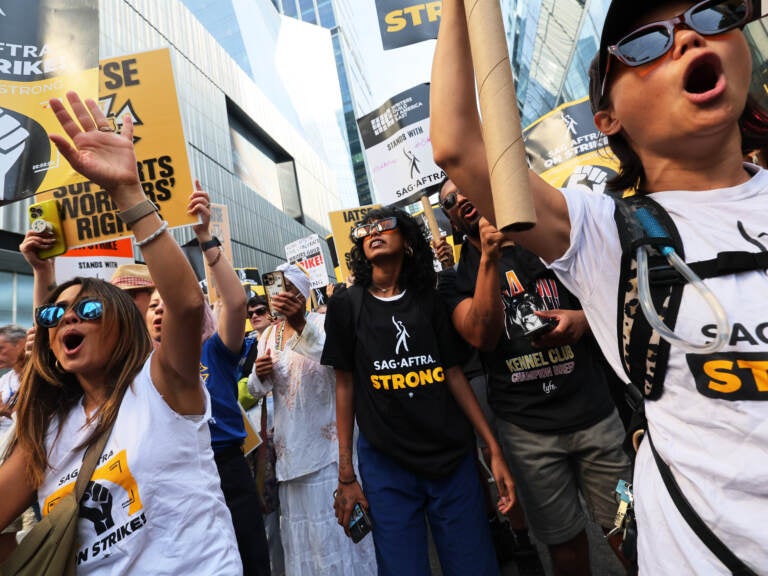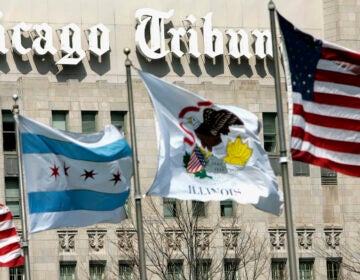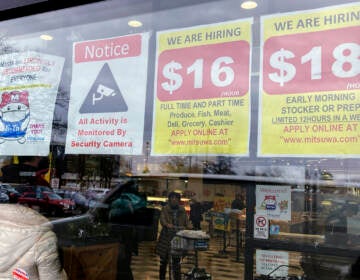4 things to know on Labor Day — from the Hot Labor Summer to the Hollywood strikes

People hold signs as members of SAG-AFTRA and Writers Guild of America East walk a picket line outside of the HBO/Amazon offices during the National Union Solidarity Day in New York City on Aug. 22, 2023. Labor unions have notched some big victories this year but organized labor still faces an uncertain future. (Michael M. Santiago/Getty Images)
This Labor Day, one thing’s for sure: Organized labor is on the move.
Unions have already notched some big wins this year, including at UPS — and they are looking for more, with writers and actors striking in Hollywood and the United Auto Workers union playing hardball in contract negotiations with the Big 3 automakers.
And now, organized labor feels like they have their winds at their back. A tight job market has given workers increased bargaining power, polls show public support for unions is high, and the Biden administration is on their side.
There are big obstacles though. Unionizing efforts face stiff opposition from many employers and there’s still considerable uncertainty about the economic outlook.
Here are four things to know about the state of the labor market on Labor Day.
Unions are flexing their muscle
If not now, when?
That’s the prevalent thinking at unions. Companies have racked up big profits during the pandemic and employers have been scrambling to find enough workers in a resilient jobs market.
And for the moment at least, unions enjoy strong public support. Autoworkers, for example, point to a Gallup poll showing 75% of people support the UAW in its contract talks with the big auto makers.
Unions also have a friendly administration in the White House right now. Vice President Kamala Harris expressed her support for organized labor last week saying unions “make our middle class and our entire economy more strong.”
A report from the Treasury Department last week showed on average, unionized workers earn 10-15% more than workers who don’t have the benefit of a union. They also enjoy better benefits, while unionized workplaces tend to see smaller racial and gender pay gaps.
And organized labor has scored some big victories lately.
Unionized pilots at American Airlines scored pay gains of more than 40% under their new contract while UPS drivers achieved what the Teamsters union calls “the most lucrative agreement” in the delivery company’s history.
“We have seen that there are examples where employers come to the table… sit down, bargain, and arrive at results,” acting Labor Secretary Julie Su told NPR in an interview. “I think that is continuing to inspire what people have called a hot labor summer.”
Still, there’s uncertainty ahead
Simply put, the best thing workers have going for them is a strong job market — but there are questions about how long that can last.
The unemployment rate has been under 4% for 19 straight months — the longest such stretch in decades. Competition for workers is pushing up wages, especially for those at the bottom of the income ladder.
But job growth is slowing, with employers adding 187,000 jobs in August, compared to an average of 312,000 jobs in the first three months of the year.
The Federal Reserve has raised interest rates aggressively since last year in a bid to fight inflation and the impact of those higher borrowing costs are still filtering through to the broader economy.
Unionizing efforts have not always succeeded
Unionization efforts have increased, but there have been mixed results.
Workers petitioned for more than 2,500 union elections last year, according to the National Labor Relations Board, the highest level in seven years.
Less than half of those elections ended in a win for the union, however, and even fewer ultimately resulted in a collective bargaining agreement.
Take Starbucks. Unionizing efforts at the coffee chain first got underway two years ago. More than 300 stores have unionized since then, but no one has won a new contract yet.
That’s contributing to a slowdown in new organizing at Starbucks as baristas don’t feel they’ve gained much for all their efforts.
Starbucks has also fought hard to dissuade people from unionizing. Baristas have been fired and stores have been closed. Federal labor officials have cited the coffee company numerous times, but Starbucks continues to deny it’s done anything illegal.
Even if company actions to fight unions are proven to be illegal, penalties are often minimal and they hence don’t serve as a deterrent.
And there are limits to how much help the White House can provide. The administration has taken steps to boost union participation in public works projects, for example. But it’s gotten nowhere with unions’ biggest priority — passing the PRO Act, which would make it easier for private sector workers to organize and harder for companies to push back.
Big fights loom ahead
It’s been a so-called “hot labor summer” — and more big battles loom in the fall.
The Hollywood writers’ strike for better pay and job security has already lasted over 100 days, surpassing the last writers’ strike in 2007.
And the UAW contract with Ford, Stellantis, and General Motors is due to expire in mid-September. The union representing auto makers is demanding big pay hikes and benefit increases and are ready to strike if they don’t get what they want.
These two fights are drawing outsized attention because of what they represent: a battle for job security in changing times.
Hollywood is going through major shifts with the surging popularity of streaming services, while Detroit is seeing auto makers pouring billions to transition into electric vehicles, which generally require fewer workers to assemble.
That creates uncertainty on both sides. Workers want a say in how these two industries should navigate those changes and anxious employers want to preserve their flexibility as much as they can.
So unions may have notched a lot some key victories as of Labor Day this year, but there are still plenty of more battles to come.
9(MDAzMzI1ODY3MDEyMzkzOTE3NjIxNDg3MQ001))




